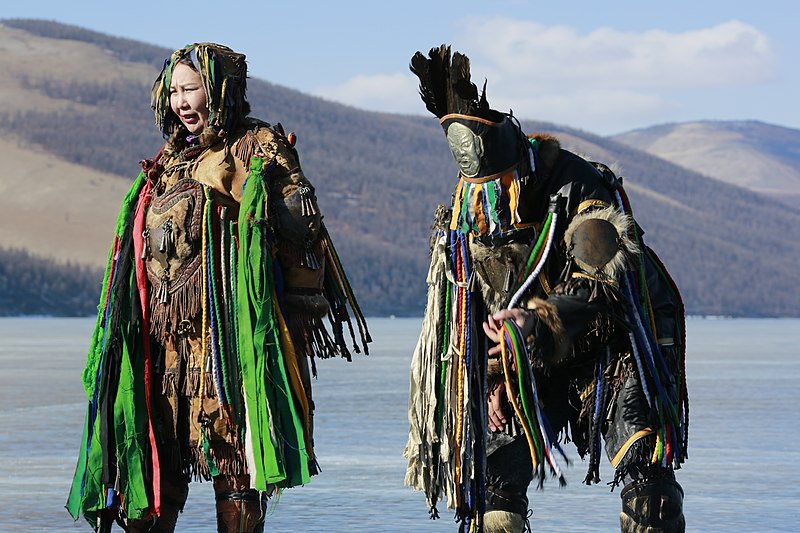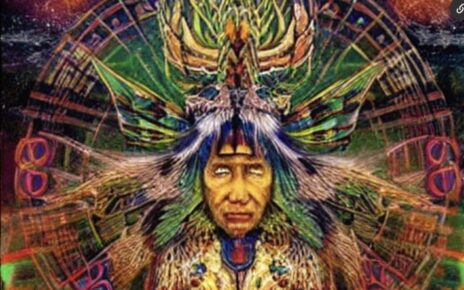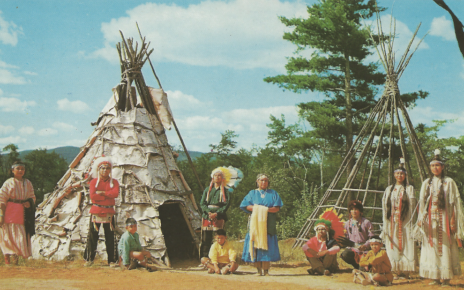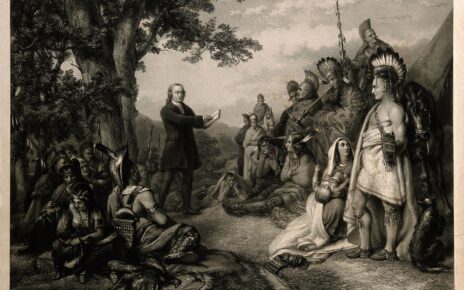The following is the second of a three-part series. The first can be found here.
As to the purpose of this spirit dancing, Kopenawa constantly emphasizes that it is a form of linguistic communication. “It is these spirits’ words that I make heard,” he writes. “It is not just my own thought” (314). More precisely, when fed by the yãkoana powder (i.e., when the shaman inhales the tree sap powder), the xapiri literally alter the shaman’s body to render him capable of receiving and understanding their dancing messages. These spirits’ dances are performed on shiny reflective surfaces (which Kopenawa calls “mirrors”), onto which the spirits descend, along gossamer-thin lines, from their palatial mansions in the skies.
“As fine and translucent as spider webs or fishing lines,” Kopenawa relates, “the xapiri’s shining paths will become fixed along our arms and legs” (referring to the limbs of an experienced Yanomami shaman) (378). “Then the spirits will come down along them to tear our chest and open a large clearing in it where they will be do their presentation dance,” Kopenawa concludes, the interpretation of dances is the shaman’s constant, lifelong occupation (378).
As Bruce Albert puts it, in his translator’s afterword to the book, “the ‘I’ of Davi Kopenawa’s account also embodies the voices of many shamanic ‘images’ of animal ancestors and cosmological beings” (447). From this, Albert concludes that his interviews with Kopenawa, which form the basis of The Falling Sky, amount to “shamanic intercultural exchanges” (448). From Albert’s outsider perspective, though, this practice initially looked unrecognizably different. “The [shamans] appear to be doing everything possible to impress their hosts with the exuberance of their performance,” he writes, recalling his “first experience of the elaborate chants, sumptuous ornamentation, and impressive choreography of such shamanic opera” (437, emphasis added).
For Kopenawa, too, the core of the spirits is dancing, as is clear from his own simple explanation of the same event: “They were making the spirits dance together” (437). Thus, the dance of the spirits is performatively identical to the dance of the shamans, which is one reason I chose the name “Spirit/Dance” for this assemblage of spiritual practices. Eschewing a more conventionally abstract title, I wished to emphasize the embodied physicality and worldliness of Spirit/Dance’s indirect empowering of revolution.
The most important contribution from Indigenous American shamanism to Spirit/Dance is the positing of not only the community healer, but also the spiritual figures whom they channel in their dancing, as essentially dancing beings. In short, these interpreted dances constitute the fundamental form of spiritual communication. And the piece of the puzzle of leftist revolution that this tradition supplies, absent or minimized in the Dionysian Mysteries and Haitian Vodou, is that these healing dances are not mere catalysts for revolution—they are the revolution itself, which has already begun as soon as the dance has begun, and has already ended if the dance does.
And this revolutionary healing dance must always be sustained, because it is necessary if our existence as the 99% is to become bearable, including in the context of impending climate catastrophe. In other words, it’s not too late to dance. It is only too late not to start dancing. Onward, then, to a further fleshing out of Spirit/Dance’s multidisciplinary magic.
Multidisciplinary Magic
This second section concerns the various “disciplines” (both academic and non-academic) on which a mage draws to make their magic. The origin of Spirit/Dance’s four-discipline schema goes back to my undergraduate years. At the encouragement of a psychology professor, I attempted to construct and make sense of my evolving identity by generating a short list of the four most important roles or positions in my life. Remarkably, these four roles—namely, “philosopher,” “psychologist,” “poet,” and “dancer”—remain at the center of my identity today, twenty-one years later.
Even more surprisingly, they have also resonated with many students, colleagues, and loved ones over the years. This ultimately persuaded me that these four roles are perhaps more fully understood relative to the most marginalized aspects of Global Northern communities, those desperately in need of reconstruction. In short, what had initially seemed most therapeutic for my broken self, now seems so for our broken communities.
In support of the latter inference, in my subsequent years in graduate school I discovered a radical social critic, namely Nietzsche, who for the first time in my philosophical education seemed to jointly perform all four of these roles in his own work. More specifically, in addition to being understood primarily (today) as a philosopher, Nietzsche also frequently describes himself in his writings as a “psychologist” (living before the disciplinary divorce whereby the APA split into the American Philosophical Association and the American Psychological Association), published a fair amount of poetry (both conventional verse and prose poetry), and practiced what he preached (in The Gay Science)about the spirit of the philosopher wanting to be nothing more than to be a good dancer. Nevertheless, what was still missing for me in Nietzsche was the explicit fusion of these four roles into one formal title that could plausibly be affirmed in the Global Northern present.
Thus, it was not until my reading took me further outside of academic philosophy, into the “ethnopoetics” of U.S. American poet and translator Jerome Rothenberg, that I first encountered the philosopher-psychologist-poetry-dancer blended into one vital institutional role, namely that of a “shaman.”[1] And since then, I have found many other concepts analogous to that of the shaman, especially in Indigenous traditions geographically and culturally connected to those whose poetry Rothenberg collects (including the Dionysian Mysteries, Shivaism, and Haitian Vodou). As a Global Northerner, however, I felt powerful ethical and political obligations not to engage in cultural appropriation, unjustly channeling the authority and authenticity of Indigenous traditions into a practice external to them.
Therefore, the name I chose for the central figure of Spirit/Dance is, not “shaman,” but “mage.” In addition to having been, according to the Online Etymology Dictionary, “an ‘archaic’ word by late 19c. (OED), revived by fantasy games,” the word mage has an Indo-European heritage with which Euro-Americans can less problematically identify, as it is derived from the Latin magus, the Greek magos, and ultimately the Persian magush (thus borrowing from the same cultural origins as Nietzsche’s Persian Zoroastrian prophet, Zarathustra).[2] Thus, philosopher + psychologist + poet + dancer = Spirit/Dance’s mage.
Though I acknowledge that there would be certain advantages in requiring each spirit-dancer to practice exactly these four disciplines, including in terms of clarity, coherence, and organizational consistency, I also see other advantages in leaving all four disciplines up to each mage to choose. Thus, I settled on the strategic compromise of proposing that all mages share the same two theoretical disciplines (philosophy and psychology), but get to choose (or create) two practical disciplines for themselves. I will now elaborate on the two shared theoretical disciplines, followed by offering the example of my own pair of practical disciplines.
Beginning with philosophy, Spirit/Dance holds that reality, even at its deepest levels, is (1) dynamic, evolving, and transformable by free action, (2) knowable only from embodied vantage points, and (3) best evaluated in the context of historical communities’ sociopolitical judgements. Characteristic (1) rules out any kind of determinism which would deny human freedom (individual or collective) at a metaphysical or scientific level. Characteristic (2) rules out any endorsement of a final, God’s-eye-view (or perfect-AI-view) of the totality of knowledge. And characteristic (3) rules out any radical subjectivism or nihilism which sanctions the atomized individual Global Northerner opting-out of their communities (being “free riders” on others’ meaning-making). Beyond these three characteristics, however, each mage is free to flesh out their philosophy as they choose.
As for the second discipline, psychology, Spirit/Dance understands the psyche/soul as an active blending of matter, imagination, reasoning, and social/political construction. Correlatedly, this psyche/soul can only heal itself, and become capable of healing others, through embodied reconstructions of imaginative content drawn from global-historical traditions. Thus, Spirit/Dance explicitly rejects any psychological view that reduces experience to the property of a disembodied mind, that minimizes the importance, productivity, and creativity of the imagination, or that reductively defines behavior in a historical-political vacuum. Overall, the point of Spirit/Dance’s psychology is that the psyche/soul is open, dynamic, creative, and perpetually amenable to the reconstructive agency of self and others.
Turning from Spirit/Dance’s required two theoretical disciplines to an example of two freely-chosen practical disciplines, the latter are essentially artforms (broadly construed) through which a mage channels their understanding and compassion, their worldview and therapeutics, into concrete, shareable, actionable performance for members of their communities. As for my own two practical disciplines, poetry and dance, I think about them as follows.
Poetry in Spirit/Dance, at the most abstract level, might be understood as an improvisational verbal art form used to preserve (through adapting) traditions of ritualized expression, by renaming the world and its aspects for a community. And dance, similarly abstractly, could function as an improvisational nonverbal art form used to provide structure, gracefulness, and joy for old and new ways of moving through the world for a community.
Put more concretely, the poetry of my own that seems to qualify as Spirit/Dance practice might include, not the formal poems published under the name “J.M.Hall” (because they are not improvisational community performances), but rather the deliberately poetic and improvisational speech of my teaching performances and mentoring and counseling sessions. And the main example of dancing that qualifies as a Spirit/Dance practice, in addition to the literal improvisational Latin jazz dancing (including salsa, bachata, and merengue) in the Birmingham social Latin dance scene, and my on-the-floor teaching thereof to first-time dancers, is the figurative “social choreography” that I help create in those weekly events qua improvisational community artworks.
This includes recruiting new folks to the scene, making sure to dance with as many different people as possible, especially members of disempowered and underrepresented groups, promoting tolerance and appreciation of queer folks (including by dancing with other men), and encouraging other veteran dancers to join me in all the above.[3]
A secondary example of my Spirit/Dance dancing might be my daily walks through Birmingham—a tree-filled metropolis whose official name is “Magic City”— which include a degree of stylization, occasional outright dance (often accompanied by music through my earphones). These walks are intended to be shared with drivers and pedestrian passers-by, in part to exhort through example a greener, healthier, more environmentally sustainable mode of transportation. And the community’s appreciation of these efforts is suggested by friends joking about seeing me strolling happily all over the heavily forested city, and even a mention of my ambles in one neighborhood newsletter.
Whatever two practical disciplines are chosen to supplement the two theoretical disciplines of philosophy and psychology, the four disciplines’ purpose is to empower Spirit/Dance’s central activity. Inspired in part by Marxist analyses of how capitalism fetishizes social activity into a seemingly-magical power of the commodity (replacing what Walter Benjamin calls the “aura” of an object’s history of production), and in part by the school of natural language philosophy, I argue for a revival of the politically energizing, yet humbly naturalistic, way that the word “magic” has historically been used in Anglophone spaces.
Put formally, “magic” in Spirit/Dance refers to free interpersonal performative action, which would otherwise appear in the form of involuntary, spontaneous states of flow, inspiration, or dynamism, but which, in the case of “magic” is (1) deliberate, (2) prioritizes empowering others over profit, and (3) requires sacrificing parts of the mage’s own being to channel and physically incorporate “spirits.”
As for the latter concept, the spirits in Spirit/Dance are the raw material, power, inspiration, energy, etc., from which a mage creates a magic. They are indefinitely numerous, include dead ancestors (like one’s great-grandfather), historical figures (like Kublai Khan), legendary heroes (like Joan of Arc), mythical beings (like water dragons), fictional characters (like a Monster High doll), and anthropomorphized places and abstractions (like the spirit of a named river), and each is representable in infinitely many ways.
The only requirements for an entity to qualify as a “spirit” is that it is not currently alive, whether because they are now deceased, or because they were never biologically born.[4] In sum, magic in Spirit/Dance always means indebtedness to others, and to our shared past, and so it must openly acknowledge, take on, and pay forward this debt to the present and future of our communities.
The most important democratic and egalitarian implication of Spirit/Dance’s conception of magic is that, for as long as any person engages in the activity understood here as “magic,” they merit the title of “mage.” And the more intensively and extensively a person performs magic, the more deserving they become of that title. In other words, this magic can be practiced by anyone who wants to devote the time and energy to it, without any bars to entering the practice based on status, birth, nationality, etc. Accordingly, Spirit/Dance rejects any formal levels of practice, or tiers of practitioners, which would relegate some persons to a higher level (comparable to a clergyperson) and others to a lower level (such as a congregation member).
Retuning to the three criteria for magic in Spirit/Dance, I will now attempt to clarify them using three corresponding counterexamples. First, it often transpires that, without deliberate effort, a person delivers a performance which is immediately enrapturing and memorable for those in its presence, as in a drunken monologue or an uncharacteristic freestyle rap session. Or, secondly, one achieves these amazing and transformative effects through performance deliberately, but in a way that exploits or otherwise harms the audience, as with a greedy televangelist, or a millionaire rockstar singing misogynistic lyrics to crowds of prepubescent boys.
And/or, thirdly, this deliberate performance does not require any sacrifice of the self of the performer, who prefers to simply augment their own ego, unjustly relegating to the shadows those who made the performance possible by coming before and inspiring them.
While condition (1) strikes me as relatively straightforward, especially in the light of the counterexample above, I can easily imagine readers misinterpreting the intent of condition (2). Though the latter is admittedly ethically value-laden, this ethicality is more of a (welcomed) side effect of that condition, rather than a determining cause thereof. To wit, I am not proposing a definition of magic that violates what philosophers call the “is/ought” distinction, as when a philosopher defines “art” in such a way that something can only be art if it is aesthetically good.
On the contrary, for Spirit/Dance, the reason that magic must be good (in this case, ethically) is not because it would be unappealing to have unethical magic, but rather because magic’s signature effects depend on its ability to empower. Thus, when magic fails to empower, it is failing to be powerful, and therefore no longer deserves the title of “magic.”
The most difficult and complex of these three conditions, however, is undoubtedly (3). As in the loosely analogous case of Vodou psychology and its possessed priests, a Spirit/Dance mage can deliberately suspend their self-conscious way of being in favor of channeling and reembodying an entity whom they consider superior in some way. To give a lowly example, if I consider my great-grandmother to be extremely stoic and persistent, then when I find myself in a difficult situation, I can try to choose not to react as I would normally do, and instead pretend that I am her, proceeding to do what I think she would do if she were in that situation. Oversimplifying, this is comparable to the “WWJD” (What Would Jesus Do?) bracelets that continue to be popular among fundamentalist Christians in the U.S. (though in the case of Spirit/Dance, the question is: “What would a small number of personally-chosen spirits do?”).[5]
My answer to the latter question amounts to Spirit/Dance’s three ultimate objectives, toward which its multidisciplinary magic aims. The first is “mindfulness,” roughly synonymous with Hannah Arendt’s concept of “thoughtfulness” (in brief, that for lack of which one risks becoming a Nazi).[6] It is a virtue primarily of the psyche/soul, especially as the latter is conceptualized in various traditions of philosophy and psychology marginalized by the birth of mainstream academic psychology.[7] The second ultimate objective, which builds on the first objective insofar as it applies to (already-) mindful psyches/souls in the community, is “liberation,” in the sense of the Latin American “liberation theology” (a neo-Marxist blend of spiritual and political freedom).
It is a virtue primarily of the body-mind, translating each embodied psyche/soul into a more free-moving agent and force in their communities. And the third ultimate objective, which builds on both the first and second objectives insofar as it applies to the (already-) liberated, (already-) mindful, embodied psyches/souls, is “social justice.” It is a virtue primarily of communities, reweaving many liberated, thoughtful body-minds into more flourishing social bodies, including voluntary associations and the body politic as a whole.
Finally from this second section, I wish to briefly note the inclusion in Spirit/Dance of a small group of accoutrements, or tools, which I call “technologies” (in part as a reminder that science and technology are not excluded, but in fact welcomed, in Spirit/Dance’s magic). My intent here is to help ground this assemblage of spiritual practices concretely in the world of things and material practices, so it does not get lost in the arid heights of abstraction where most academic philosophers’ creations go to die (since most non-academics cannot find purchase or sufficient oxygen there). In my current formulation, each mage is advised to collect four such technologies (or identify those which they already possess), which I now present, in an order with no implied ranking.
First, each mage should have a “mantle,” defined as an article of clothing that psychosomatically protects and psycho-socially empowers them, by projecting their reputation to the community. My own mantle, for example, would probably be a dark gray wool overcoat, in which I can almost always be seen wrapped during the colder seasons of my daily walks in Birmingham, especially when paired with a rotating assortment of scarves, which were handknit for me by various loves ones over the years.
Second, a mage’s “charm” is a small item, worn or carried, that empowers self-directed or concentrating magic (as opposed to others-directed or radiating magic). My charm, for certain, is a small steel ring in the style of the signature item of the DC comic-book superhero “Green Lantern.” In that fictional universe, the Lanterns are an intergalactic, multispecies corps of cosmic guardians, each chosen based on personality-fit and virtue, and their power ring represents willpower and imagination, drawing on the material energy of the eponymous lantern during regular charging sessions.
What this means to me, viz Spirit/Dance, is that one’s power of creative construction is bounded only by the scope of one’s imagination, the firmness of one’s resolve, one’s fidelity to serving the community in an order of fellow guardians, and one’s regularly attending to recharging one’s material resources (including through sleep, healthy nutrition, and emotionally restorative interactions and relationships).
Third, a mage’s “armament” is a literal or figurative weapon that helps empower world-directed or radiating magic, which thus functions in a kind of mutually empowering or oscillating relationship with the “charm” (which, to repeat, focuses self-directed or concentrating magic). My own armament would probably be my laptop computer, the twenty-first century analogue of the mightier-than-sword pen. Most important of my laptop-empowered creations would be the uncountably numerous improvised email I have sent over the years to students, former students, mentees, and counseling clients, each one tweak to try to match the needs of the individual in that moment.
And lastly, a mage’s “familiar” is a real or imaginary nonhuman animal or plant species with which a mage feels kinship, reminding them of their own animality and inherent connection to their ecosystem. Mine, unquestionably, would be the ever-present Deep South songster, he of many borrowed voices, the beautiful mockingbird. In addition to my activism being partially inspired by the titular mockingbird of Harper Lee’s Pulitzer Prize-winning novel, and my identifying (qua poet) with the mockingbird’s mimicry, I also performed a surprising experiment with member of that species, years ago, that has yielded a new degree of inspiring kinship.
As I have explored elsewhere, I composed a little musical phrase and whistled it to mockingbirds in different neighborhoods for several weeks of my daily walks in the evergreen Magic City. Not only did the mockingbirds quickly learned and repeated the little phrase to me, but each has its own distinct variation thereon, and eventually they started singing it at first sight of me, without my even having whistled a single note. Each time it happens, I feel radically more connected to the cosmos, sharing a life between two species whose most recent common ancestor lived roughly 320,000,000 years ago, in a figurative dancing dialogue that stretches back from before we were human, and toward what we may yet be.[8]
Joshua M. Hall, clinical ethicist at UAB Medical Center (fourth-largest hospital in the U.S.), earned his Ph.D. from Vanderbilt University, and served as a tenure-track Assistant Professor of Philosophy at William Paterson University. His research focuses various historical and geographical lenses on philosophy’s boundaries, particularly the intersection of aesthetics, psychology and social justice. This includes sixty-five peer-reviewed journal articles (including in The Pluralist, Philosophy and Literature, and Oxford University’s Essays in Criticism), ten anthology chapters, and coediting (with Sarah Tyson) Philosophy Imprisoned: The Love of Wisdom in the Age of Mass Incarceration.
[1] See Technicians of the Sacred: A Range of Poetries from Africa, America, Asia, Europe and Oceania, 2nd ed., ed. Jerome Rothenberg (Oakland, CA: University of California Press, 2005).
[2] For more, see https://www.etymonline.com/word/mage.
[3] For an opposing, pejorative conception of “social choreography,” see Andrew Hewitt, Social Choreography: Ideology as Performance in Dance in Everyday Movement (Durham, NC: Duke University Press, 2005.
[4] The main reason for this condition is the imperative to avoid the problematic tendency to reify and objectify living persons into a kind of personal spiritual handmaiden (as in the popular line today, “She’s my spirit animal”). This is even more problematic given the historical tendency of disproportionately involving women of color, which is arguably racist in its effects (despite an often-admirable conscious intention to affirm the person in question).
[5] As to the existence of a Supreme Being, Spirit/Dance remains deliberately neutral. Thus, theists, atheists, and agnostics are equally welcome and respected.
[6] For more on this interpretation of Arendt’s notion, see Joshua M. Hall, “Twixt Mages and Monsters: Arendt on the Dark Art of Forgiveness,” The Philosophy of Forgiveness, Vol. 2: Dimensions of Forgiveness, ed. Court Lewis (Wilmington, DE: Vernon, 2016), 215-240.
[7] For more on these conceptions of the psyche, see Joshua M. Hall, “Plato’s Phaedrus after Descartes’ Passions: Reviving Reason’s Political Force,” Lo Sguardo: Journal of Philosophy 27: 2019, 75-93.
[8] See Joshua M. Hall, “Trans-Religious Dancing Dialogues: Michel Henry on Dionysus and the Crucified,” Culture and Dialogue 9(2): 2021: 243-264




